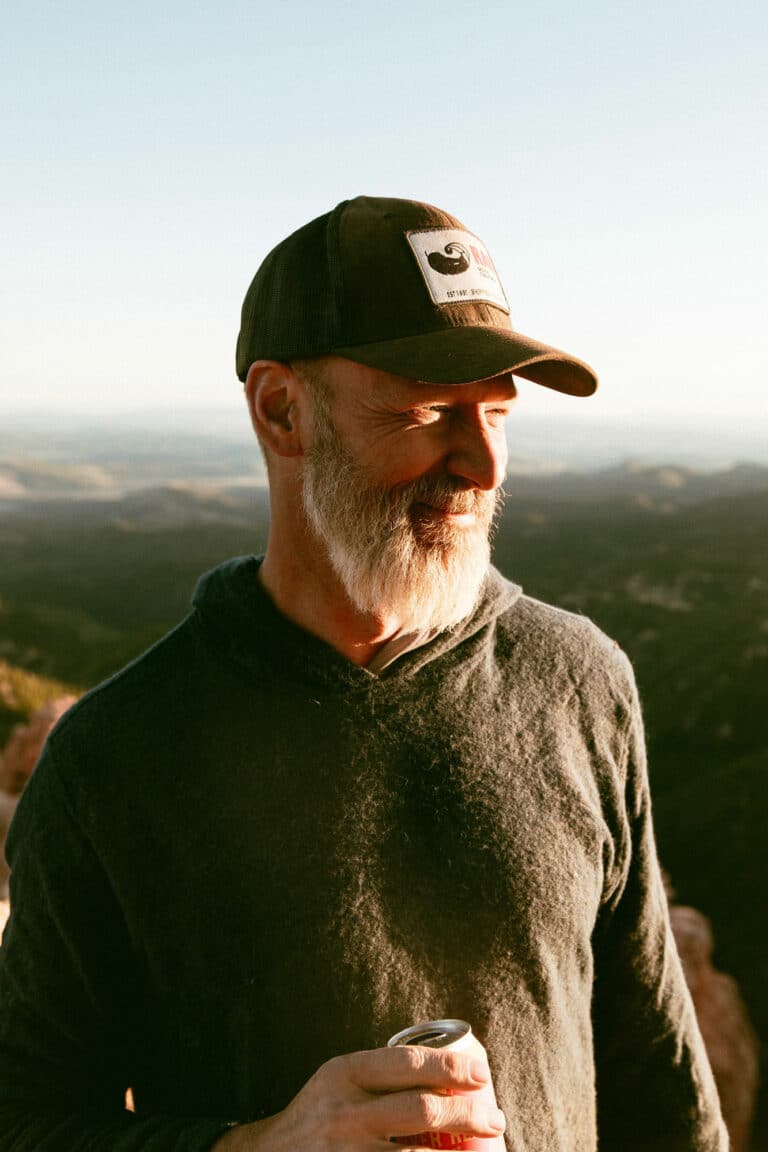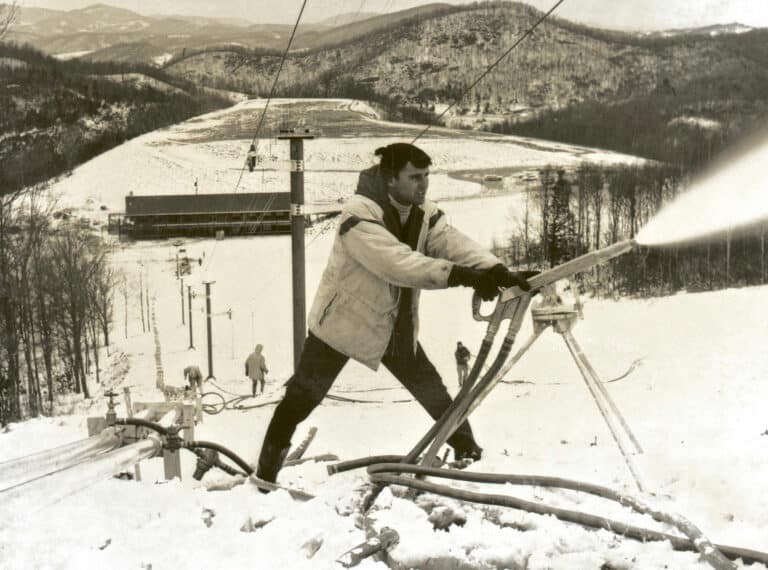How did iconic rapids and climbing routes get their names?
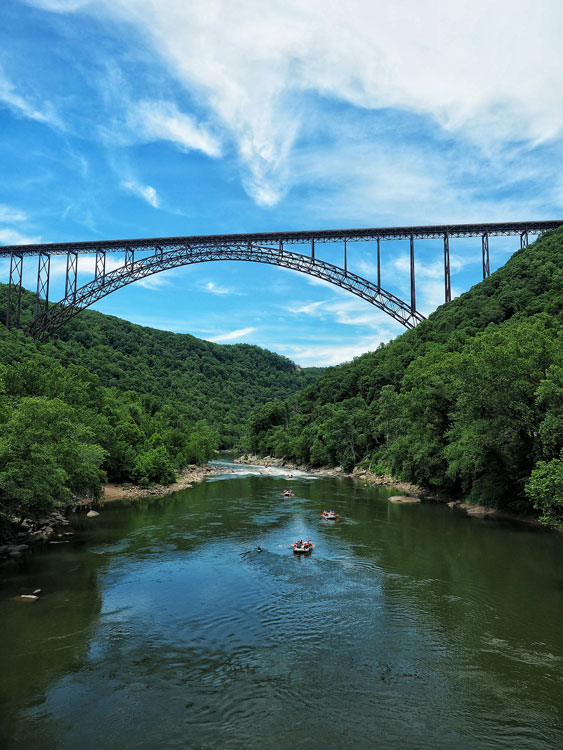
Visitors to the Blue Ridge often remark that the names of our mountains are
Flip through any climbing guidebook today, and you’ll find a range of colorful, silly, or cryptic route names: Pudd’s Pretty Dress, Death by Chewing Insects, I’m So F’in Hungry, and Eye of the Narwhal. Names of rapids can be just as out there but are often more candid. Iron Ring on the Gauley River is named for a big iron ring embedded in the rocks above the class V rapid. The four drops of Pipeline on the James River in Virginia were creatively dubbed First, Second, Third, and Fourth Drop. Not all river feature names are as universally accepted as climbing routes, either. Want to start an afternoon-long debate with some James River paddlers? Ask whether one break in an old Richmond dam is called Grummans or Suckers.
The Legend of Bubba
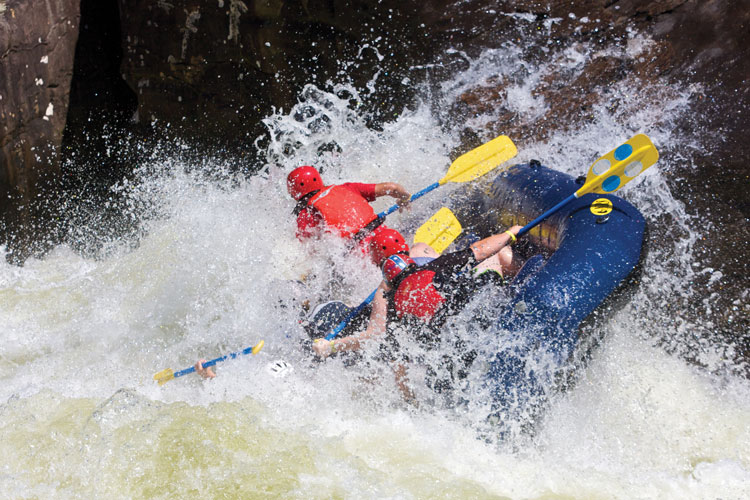
Mike Williams, a climbing guide and author of the New River Rock guidebooks, has been climbing in the New since 1998, establishing many of the most popular routes. He points out that “a lot of tall tales” characterize the region and climbing in general. “It’s an oral history. Someone puts up a new route, and they might note all the things that happened that day,” like who was with them and what they were thinking. Any of those factors could contribute to the new route’s name, but some climbers take it more seriously than others.
One area in the New, Bubba City, got its name because prolific climber Kenny Parker and friends thought some other climbers took route naming too seriously. “In climbing, as in all sports, everyone thinks their attitude is the best. We were just having fun, and we never thought what we were doing had any greater meaning,” says Parker, who has almost 30 years of New River Gorge first ascents. At that time, he says, “Staying out of the line of fire with the locals, laying low, was always a strategy.” He says back in the 80s and early 90s, much of the land, like Endless Wall, was still privately owned. If one wanted to continue to climb there, standing out or directly disrespecting the locals was nonsensical.
A short profile of Parker in Williams’s New River Rock Vol. 2 guidebook, appropriately titled Kenny Never Wore Lycra, highlights his desire to blend in rather than stand out like many neon-clad climbers of that era. “Bubba” became tradition, and today it lives on in dozens of route names, from Peanut Bubba and Jam (a 40-feet 5.8 trad route at Bimbo Buttress) to Hubba Bubba (a 60-feet 5.9 sport route on the Head Wall).
Sometimes, two threads of regional climbing history come together in one weird name. Kenny Parker relays that when he was younger, many climbers started at Seneca Rocks before the New matured into a hotspot. At Seneca, they looked up to one of the most impressive climbers of the day, the late Cal Swoager. A Vietnam War veteran, Cal partied hard and climbed harder. As one story goes, after staying up late then finally topping The Bell, establishing perhaps the first 5.12 at Seneca, he bent over and emptied his stomach off the other side of the cliff.
Swoager was welcoming and encouraging to budding climbers and sent routes with Kenny at Seneca. Some time later, he became a born-again Christian and part of the development of climbing at the New. His passion for his religion fed into nearly every route he established, from the ever-popular Leave it to Jesus to Team Jesus and Never Alone (all first ascents in 1985). Later routes began to play off the legendary Swoager’s love for the cross, and routes like Bubba Meets Jesus, a 60-feet 5.11a established by Dave Merritt, were born.
The Hookup Spot
Another unforgettable Kenny tale revolves around one unofficial campsite. Apparently unbeknownst to climbers, a certain bridge was a known local spot for covert coitus. Because of its proximity to a popular crag, it also became a logical spot for visiting climbers to camp. “We would drive up and sleep at pull-offs in the gorge. There had been incidents involving law enforcement,” Parker describes, “but it was sort of under the radar. We had encounters where locals thought we were there [for hookups].” He describes how one time a group of climbers were camped out at the spot, some in tents or just sleeping bags, some in trucks.
One of them, let’s call him Mark, had the unfortunate habit of sleeping in the buff. Mark had gotten up in the night to use the bathroom donning only boots and birthday suit. Kenny says, “I get woken up to someone outside; I’m like, ‘Mark, what the hell is going on?’ He had gotten caught outside naked by these two girls,” who were supposedly there to bait guys meeting up for other reasons. Kenny, after getting dressed, exited his tent to deal with the situation.
“Next thing I know, a car comes rolling up, and it’s their boyfriends. One guy gets out, but the girls talk him down, having figured out I was fine.” Parker proffers a beer as a peace offering, but the second man wants to start a fight. “I’m getting shoved while the girls try to break it up.” Eventually, things simmered down. “I think I hung out with them for awhile, and they went away. But the very next weekend, with the same group at the exact same spot, we were woken up again by the same girls,” this time asking for Parker. They hung out for awhile, locals and climbers. When asked what route name arose from all that, he says, “A number of them.”
Rapids often get their names from happenstance or a comical turn of events. Lost Paddle, one of the Big Five rapids of the Upper Gauley, found its label during a 1969 trip devoted to naming the river’s rapids. In a 2017 piece for Highland Outdoors, editor and raft guide Juniper Rose relays pioneer Gauley kayaker Jim Stuart’s account of the naming trip. “Crew member Barb Brown’s paddle was launched from her grip in the class V rapid just below the confluence with the Meadow River.” Brown swam, her paddle gone. Miraculously, “years later, Brown’s paddle was found with her name engraved on it. It was returned to her, but by then, the name Lost Paddle had been imprinted in the legend of the Gauley,” Rose writes.
Trad vs. Sport
Names have long been used to either nod or jab at others. Advocates for two styles of climbing, traditional (trad) and sport, have butted heads since the latter was invented. Trad climbing requires gear like cams, nuts, and sometimes hexes, which the climber must place in natural cracks for protection as they climb upward. Sport climbing allows for bolts to be drilled into the rock every few feet so that climbers only have to bring quickdraws to clip into the bolts as they lead. The trad-or-die tribe believes that sport climbing defaces the rock and allows for the first-ascensionist to rappel down the face, drilling bolts in preparation for a ground-up push. Sport climbers see their preferred process as an inevitable evolution of climbing, opening up more diverse rock that would otherwise be inaccessible.
Others still, like Kenny, might have resisted it in the past but came to see the benefits of each. “Ethics wars between trad and sport were huge in the 90s; people got into fights over it,” he says. “Still, there was a lot more seriousness to the famous areas [like Yosemite]. Here, some people got serious about it, but most of us had a life and jobs outside of climbing and not enough personal energy to crusade.” This story is told in part by Saved from the Blasphemers, a route which was put up on trad gear. When someone returned to bolt it as a sport route, they were stopped by local trad climbers.
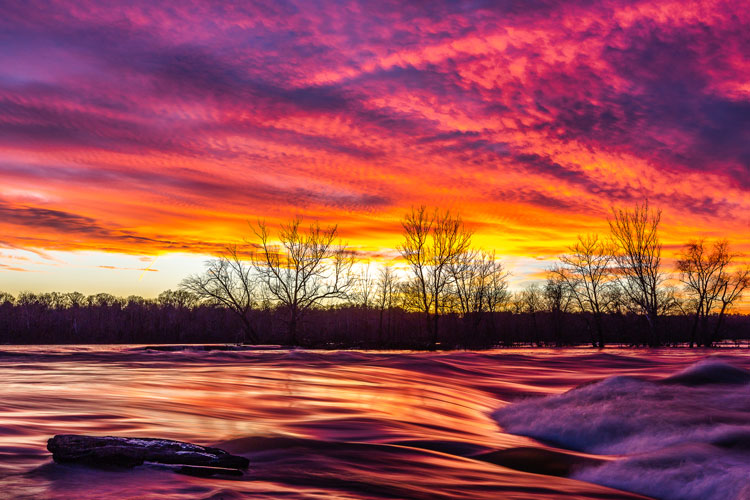
A ‘Travisty’
The intentionally-misspelled Travisty is another example of trad-sport tension. This route’s origin story is told by Mike Williams in an article published on his blog “Mike’s Ironclad Beta” in 2012. When a visiting climber named Travis bolted a hard climb at Beauty Mountain, he drilled some holds in the rock to make it easier. “After his departure, the holds were filled in with epoxy and when Harrison Dekker completed the climb [in 1991] in its natural state, he couldn’t resist the opportunity to exploit the unfortunately-named equipper. Years later, an inferior, traditionally protected variation to the route was done and dubbed the Tradjedy.”
Outside of the sport itself, names also point to paradigm shifts in the history of regional recreation and external tension that inevitably arises from priorities competing for the resource. A lifelong James River paddler, Charles Ware recounts the fight against hydroelectric power in the early 80s. One firm’s proposal became a serious threat to river ecology and recreation, prompting Coastal Canoeists and American Whitewater to establish a group to oppose the plan: the Virginia Rivers Coalition.
To increase awareness of the issue and publicize local river recreation, they conceived of an urban whitewater race day and sought sponsorship. The first downriver race in 1983 was roughly eight miles long and included the infamous Hollywood rapid, with a take-out at Ancarrow’s Landing, well below the Falls of the James. It was essential that everyone run through one particular dam, in the middle of downtown Richmond, correctly, and while local participants knew the maneuver well, the Coalition thought visiting competitors should have a visual marker.
Just before the race, the river was low enough to allow Ware to paddle out to the dam in a canoe and spray paint two giant Xs on the bridge pillar ruins that abutted the proper line. The paint, supplied by a utility opposed to the power proposal (imagine that!), was said to wash out in a few days. But there the Xs remained for ten years, until they were updated to skulls and crossbones. The name of the line, Xs, was given in the 1985 race and has stuck ever since. As for the electric proposal, it was foiled. The descendants of those regional pioneer paddlers, like Ware’s son John, continue to run the James’ class I-IV rapids, while other rivers around the world continue the fight against hydroelectric dams.
Names or rapids and routes can be steeped in mythology. When asked what mythology in climbing means to him, Mike Williams puts it succinctly: “Mythology doesn’t have to be true. It’s an oral history, often based on a sort of campfire mythology.” Embellished details, memories fogged by both time and intoxication, different versions of the same event… Humans are adept, if not objective, storytellers; we’ve named everything since the dawn of language. The mountains and rivers couldn’t care less what we call them, but no matter what’s in a name, the act of naming lets someone leave their mark on history, cement in some small, symbolic way their side of a great story.

